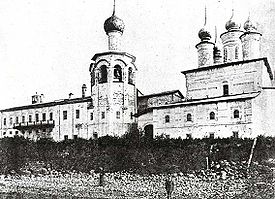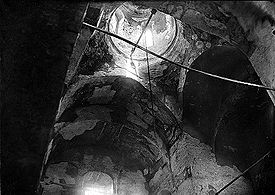
Kamenny Monastery
Encyclopedia

Kamenny Island (literally, "Stony Island") is very small, measuring just 120 metres by 70 metres. It is so named after stony ramparts set up by the monks around the island's perimeter in order to preclude its erosion. The lake is known for its inclement weather and frequent storms. It is believed that during one of such storms in 1269 Duke Gleb of Beloozero was cast ashore, where he found a small monastic community. The legends of the monks attribute the construction of the first timber cathedral on the isle to the funds subsequently provided by that monarch.
Under Dmitry Donskoy, the Kamenny Monastery was run by Dionisius, a Greek monk who introduced the coenobian rule of Mount Athos
Mount Athos
Mount Athos is a mountain and peninsula in Macedonia, Greece. A World Heritage Site, it is home to 20 Eastern Orthodox monasteries and forms a self-governed monastic state within the sovereignty of the Hellenic Republic. Spiritually, Mount Athos comes under the direct jurisdiction of the...
, whereby the brethren were closed alike, took their meals (usually limited to bread and scarce vegetables) in the refectory and were bound to possess no private property. Female animals were banned from the isle to avoid any impure thought on the part of the monks.
The monastery was quite rich, owning seven larger villages (selo), four average villages (seltso) and 98 small villages, in addition to two salt pans in Totma
Totma
Totma is a town and the administrative center of Totemsky District of Vologda Oblast, Russia,, located on the left bank of the Sukhona River at the confluence with the Pesya Denga River. Municipally, it is incorporated as Totemskoe Urban Settlement in Totemsky Municipal District. Population:...
and two branches in Vologda
Vologda
Vologda is a city and the administrative, cultural, and scientific center of Vologda Oblast, Russia, located on the Vologda River. The city is a major transport knot of the Northwest of Russia. Vologda is among the Russian cities possessing an especially valuable historical heritage...
. The monastic community reached its peak under Paisiy Yaroslavov
Paisiy Yaroslavov
Paisiy Yaroslavov was the most famous monk of the Kamenny Monastery, located on the Lake Kubenskoye in Vologda Oblast, Russia.Historians do not know much about Paisiy Yaroslavov. He appears to have been a prominent figure during the reign of Ivan III. In 1478-1482, he was an hegumen at the...
, a former hegumen
Hegumen
Hegumen, hegumenos, igumen, or ihumen is the title for the head of a monastery of the Eastern Orthodox Church or Eastern Catholic Churches, similar to the one of abbot. The head of a convent of nuns is called hegumenia or ihumenia . The term means "the one who is in charge", "the leader" in...
of the Trinity Lavra and one of the most influential clerics of the time. This starets
Starets
A starets is an elder of a Russian Orthodox monastery who functions as venerated adviser and teacher. Elders or spiritual fathers are charismatic spiritual leaders whose wisdom stems from God as obtained from ascetic experience...
authored The Tale of the Kamenny Monastery whose main themes are the history of this monastery and the struggle of its monks against paganism
Paganism
Paganism is a blanket term, typically used to refer to non-Abrahamic, indigenous polytheistic religious traditions....
in the area.
In 1476 the monastery burnt down. Ivan III's brother Andrey Menshoy, who was the ruler of Vologda, commissioned a stone four-pillared cathedral to be built on the island. The two-storey two-domed edifice was constructed in 1481 by a team of masters from Rostov
Rostov
Rostov is a town in Yaroslavl Oblast, Russia, one of the oldest in the country and a tourist center of the Golden Ring. It is located on the shores of Lake Nero, northeast of Moscow. Population:...
, who proceeded to erect very similar cathedrals in the Ferapontov Monastery
Ferapontov Monastery
The Ferapontov convent , in the Vologda region of Russia, is considered one of the purest examples of Russian medieval art, a reason given by UNESCO for its inscription on the World Heritage List....
(1490) and Kirillo-Belozersky Monastery
Kirillo-Belozersky Monastery
Kirillo-Belozersky Monastery , loosely translated in English as the St. Cyril-Belozersk Monastery, used to be the largest monastery of Northern Russia. The monastery was dedicated to the Feast of the Dormition of the Theotokos, for which cause it was sometimes referred to as the Dormition Monastery...
(1497). Paisiy Yaroslavov mentions that he engaged the great artist Dionisius
Dionisius
Dionisius was acknowledged as a head of the Moscow school of icon painters at the turn of the 15th and 16th centuries. His style of painting is sometimes termed "the Muscovite mannerism"....
to paint a deesis
Deesis
In Byzantine art, and later Eastern Orthodox art generally, the Deësis or Deisis , is a traditional iconic representation of Christ in Majesty or Christ Pantocrator: enthroned, carrying a book, and flanked by the Virgin Mary and St. John the Baptist, and sometimes other saints and angels...
for the cathedral. It is believed that Dionisius's works perished 185 years later, during a great fire, which resulted in the collapse of the domes.

The Soviet government closed down the Kamenny Monastery in 1925 and had its brethren evacuated from the island. The buildings were adapted to house a penal colony for minor delinquents. This establishment proved a failure and by 1937 the island had been deserted. The regional administration profited from the situation to blow up the oldest building of the Russian North in order to obtain brick required for construction of the local "palace of culture
Palace of Culture
Palace of Culture or House of Culture was the name for major club-houses in the former Soviet Union and the rest of the Eastern bloc. It was an establishment for all kinds of recreational activities and hobbies: sports, collecting, arts, etc., and the Palace of Culture was designed to have room...
", which eventually failed to materialise. The ruins of the cathedral are still in situ
In situ
In situ is a Latin phrase which translated literally as 'In position'. It is used in many different contexts.-Aerospace:In the aerospace industry, equipment on board aircraft must be tested in situ, or in place, to confirm everything functions properly as a system. Individually, each piece may...
(picture).
, the only building marking the spot of the historic monastery is the church belltower from the 1540s, which is now being repaired by a team of enthusiasts from Vologda and Moscow. As the team is out of funds, the future of this medieval compound looks bleak.

